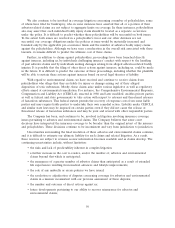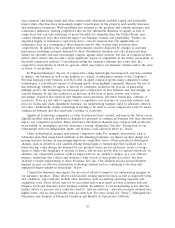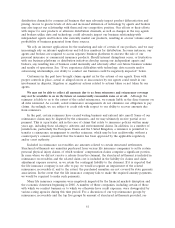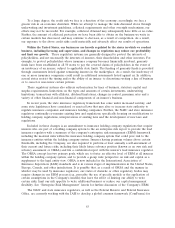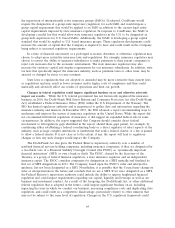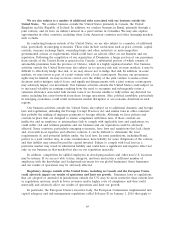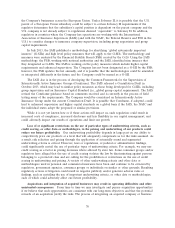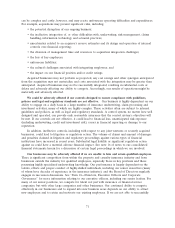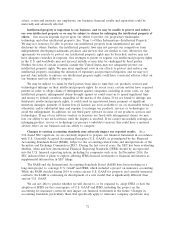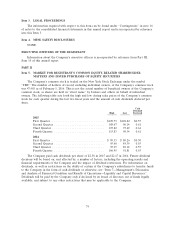Travelers 2015 Annual Report Download - page 66
Download and view the complete annual report
Please find page 66 of the 2015 Travelers annual report below. You can navigate through the pages in the report by either clicking on the pages listed below, or by using the keyword search tool below to find specific information within the annual report.The inability of our insurance subsidiaries to pay dividends to our holding company in an amount
sufficient to meet our debt service obligations and other cash requirements could harm our ability to
meet our obligations, to pay future shareholder dividends and to make share repurchases.
Our efforts to develop new products or expand in targeted markets may not be successful and
may create enhanced risks. A number of our recent and planned business initiatives involve
developing new products or expanding existing products in targeted markets. This includes the
following efforts, from time to time, to protect or grow market share:
• We may develop products that insure risks we have not previously insured, contain new coverage
or coverage terms or contain different commission terms.
• We may refine our underwriting processes.
• We may seek to expand distribution channels.
• We may focus on geographic markets within or outside of the United States where we have had
relatively little or no market share.
We may not be successful in introducing new products or expanding in targeted markets and, even
if we are successful, these efforts may create enhanced risks. Among other risks:
• Demand for new products or in new markets may not meet our expectations.
• To the extent we are able to market new products or expand in new markets, our risk exposures
may change, and the data and models we use to manage such exposures may not be as
sophisticated or effective as those we use in existing markets or with existing products. This, in
turn, could lead to losses in excess of our expectations.
• Models underlying automated underwriting and pricing decisions may not be effective.
• Efforts to develop new products or markets have the potential to create or increase distribution
channel conflict, such as described above under ‘‘—Disruptions to our relationships with our
independent agents and brokers could adversely affect us.’’
• In connection with the conversion of existing policyholders to a new product, some
policyholders’ pricing may increase, while the pricing for other policyholders may decrease, the
net impact of which could negatively impact retention and profit margins.
• To develop new products or markets, we may need to make substantial capital and operating
expenditures, which may also negatively impact results in the near term.
If our efforts to develop new products or expand in targeted markets are not successful, our results
of operations could be materially and adversely affected.
We may be adversely affected if our pricing and capital models provide materially different
indications than actual results. The profitability of our property and casualty business substantially
depends on the extent to which our actual claims experience is consistent with the assumptions we use
in pricing our policies. We utilize proprietary and third party models to help us price business in a
manner that is intended to be consistent, over time, with actual results and return objectives. We
incorporate the Company’s historical loss experience, external industry data and economic indices into
our modeling processes, and we use various methods, including predictive modeling, forecasting and
sophisticated simulation modeling techniques, to analyze loss trends and the risks associated with our
assets and liabilities. We also use these modeling processes, analyses and methods in making
underwriting, pricing and reinsurance decisions as part of managing our exposure to catastrophes and
other extreme adverse events. These modeling processes incorporate numerous assumptions and
forecasts about the future level and variability of: interest rates, inflation, capital requirements, and
66


